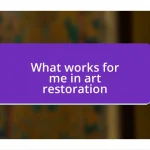Key takeaways:
- Impressionist techniques focus on capturing light and movement through vibrant colors and spontaneous brush strokes, allowing artists to express emotions and invite viewers to experience the scene.
- The historical context of Impressionism emerged during the late 19th century, influenced by the Industrial Revolution, the rise of photography, and cultural shifts, which encouraged artists to challenge traditional norms.
- Personal growth in art comes from the emotional connections made during the creative process, where the act of painting can reflect one’s inner evolution and foster vulnerability through sharing work with others.

Understanding Impressionist Techniques
Impressionist techniques are fascinating because they break away from traditional methods, focusing instead on capturing light and movement. I remember my first encounter with an Impressionist painting; the way the colors blended and shifted almost made me feel the scene rather than just see it. Isn’t it intriguing how brush strokes seem to dance across the canvas, creating a sense of spontaneity?
One of the hallmarks of Impressionism is the use of bright, vibrant colors, often applied straight from the tube. This approach encourages a more emotive response from the viewer, as I found out when I experimented with it myself. When painting “en plein air” (a French term meaning “in the open air”), I realized how the changing light throughout the day can alter not just the colors but also the mood of a piece—doesn’t that thought inspire you to grab a brush and try it out?
Another distinctive aspect is the emphasis on everyday subject matter. Impressionists were drawn to ordinary scenes, like bustling streets or quiet gardens, finding beauty in the mundane. One afternoon, as I observed my neighborhood, I felt a jolt of inspiration, noticing how the light filtered through the leaves, casting playful shadows on the ground. Isn’t it refreshing to think that true artistry can emerge from our daily surroundings?

Exploring Historical Context
The historical context of Impressionism is a remarkable tapestry interwoven with revolution and change. This movement emerged in France during the late 19th century, a time when artists sought to break free from established norms. I often reflect on the cultural upheaval of that era, where artists like Monet, Degas, and Renoir were pushing against the constraints of academic painting. It’s fascinating to consider how they used their brushes to challenge societal expectations just as the broader world was undergoing transformations in technology, politics, and daily life.
- Impressionism developed during the:
- Industrial Revolution, which introduced new urban landscapes.
- Rise of photography, prompting painters to explore the momentary experience.
- Growing interest in science, particularly in the study of color and light.
- Cultural shifts, including the emergence of a leisure class enjoying the outdoors.
The personal narrative of grappling with these historical nuances resonates deeply with me. One day while visiting an art museum, I stood before a vibrant Monet, marveling at how his work captured the very essence of fleeting moments. It made me ponder how these artists were not just painting; they were recording the rhythm of a world in flux, inviting us to appreciate life’s transient beauty. Isn’t it peculiar how a single brushstroke can evoke a story of societal evolution, while simultaneously stirring our emotions?

Choosing the Right Materials
Choosing the right materials for Impressionist painting can greatly influence the final artwork. I remember my early attempts when I realized the importance of selecting high-quality paints. Using professional-grade oil paints instead of student brands transformed my experience. The richness and vibrancy of colors are essential to truly capture the essence of light and movement found in Impressionism.
When we consider brushes, not all are made equal. Sable brushes, for instance, hold a lot of paint and create beautiful, fluid strokes. I still recall the first time I switched to using these brushes; it felt like my brushstrokes were more alive, allowing me to express the spontaneity that is so key to this style. The right materials can definitely lead to a more satisfying creative journey.
Moreover, choosing the surface is just as crucial. Canvas, wood panels, or even heavy paper can all work, but I’ve found that a primed canvas gives that classic feel I love in Impressionist works. I can still visualize the soft texture of the canvas under my fingers as I applied paint. Each decision shapes the painting’s final look and evokes its emotional depth.
| Material | Description |
|---|---|
| Oil Paints | Vibrant colors, ideal for blending and layering. |
| Brushes | Sable brushes are excellent for fluid strokes; synthetic brushes are more affordable. |
| Surfaces | Primed canvas enhances texture; wood panels can provide stiffness. |

Mastering Brush Stroke Techniques
Mastering brushstroke techniques is where the magic truly happens for me in Impressionism. Each stroke can be a dance of expression, a single movement that conveys light, shadow, and emotion. I vividly recall a moment when I experimented with quick, flicking motions with my brush; the exhilaration I felt as colors blended harmoniously on the canvas was unlike anything else. How can something as simple as a brushstroke unlock such emotional depth?
The use of varied strokes—whether short and choppy or long and sweeping—allowed me to experiment with texture and rhythm in my paintings. I remember once layering quick, dabbing strokes to create a sense of foliage in one piece. Each application felt like adding a heartbeat to the work, breathing life into the scene. It’s amazing how those seemingly spontaneous movements can capture such delicate nuances of light, isn’t it?
Additionally, I often find that adjusting the angle and pressure of my brush creates astonishingly different results. One time, while painting a sunset, I lightly grazed the canvas with my brush at an angle, which resulted in soft, glowing clouds. The thrill of unraveling such effects keeps my artistic journey vibrant. It’s those moments of discovery that remind me there’s no single right way to paint—it’s all about how I connect with each stroke that truly matters.

Experimenting with Light and Color
Experimenting with light and color has been nothing short of a revelation for me. There was a day when I stepped outside with my palette and easel, determined to capture the way the sun flickered through the leaves. As I mixed vibrant yellows and soft greens, the sheer joy of seeing those colors come to life made me realize how crucial they are in representing not just a scene, but a feeling. Isn’t it fascinating how color itself can evoke emotions nearly as deeply as the subject matter?
One time, while painting a bustling street scene, I noticed how light changed throughout the day. I decided to mimic these shifts on my canvas. I layered warm oranges for the midday sun but added cooler blues as evening approached. The transformation was electrifying! I remember looking at the finished piece and feeling a vibrant pulse echoing the energy of the moment I had experienced. This taught me that playing with light isn’t just about representation; it’s about storytelling through color.
Through these experiments, I’ve come to appreciate that even the shadows have their own palette. I recall painting a quiet corner in my garden, and at first, I thought shadows were merely dark patches. But I decided to add hints of violet and deep blue, which revealed a hidden depth and serenity to the scene. This exploration has shown me that light and shadow are partners in the dance of color, and I can’t help but wonder: how can a single hue shift the mood entirely in a painting?

Creating Your Own Impressionist Piece
Creating your own Impressionist piece is truly an adventure in self-expression. I still remember the excitement of my first attempt; I set up my easel in a sun-drenched park, and instead of sketching outlines, I focused on capturing the essence of the scene with a playful application of color. As I layered blues, greens, and yellows with a palette knife, I felt as if I were sculpting light itself. Isn’t it incredible how a few bold strokes can bring a landscape to life?
To immerse myself further, I decided to embody the Impressionist philosophy of painting en plein air. One afternoon, I sat by a shimmering lake, allowing the natural beauty around me to guide my brush. I found myself entranced not just by what I saw, but by how I felt in that moment—the cool breeze on my face, the sound of water rippling. This experience taught me that creating art isn’t merely about technique; it’s deeply about feeling and connecting with the world around us. Have you ever let your emotions guide your brush, too?
When I began integrating rhythm into my brushwork, something transformed within me. I remember layering thick, expressive strokes to convey the swirling movement of a bustling cityscape. The energy of the brush danced across the canvas, capturing both chaos and harmony. This journey into rhythm reminded me that art can be as much about movement as it is about stillness. Isn’t it fascinating how a single brushstroke can whisper a story or shout a feeling? Each piece I create becomes a conversation between my heart and the canvas, a dance of colors that invites others to feel alongside me.

Reflecting on Personal Growth
Reflecting on my personal growth through impressionist techniques has been a journey of discovery. I remember the first time I stepped back from a painting, surprised by my own transformation. I realized that each brushstroke not only changed the canvas but also revealed something profound about how I perceive the world. Have you ever felt that your art mirrors your inner evolution?
In my exploration of this style, I noticed how the flurry of colors and shapes brought forth my own emotions—sometimes chaotic, other times serene. I once painted a twilight scene, and as I mixed deep purples and soft pinks, I felt an unexpected rush of nostalgia for evenings spent with loved ones. It was then that I understood how art can serve as a bridge, connecting past experiences with present feelings. Isn’t it interesting how our brush holds the weight of our memories?
Looking back, the transformation I’ve undergone isn’t just in my technique but also in my perspective. There was a moment during a workshop when I hesitated to share my work, fearing judgment. But as I watched others open up, I felt a surge of courage. Sharing my art became a way to communicate my growth—not just as an artist, but as a person engaging with life. How has sharing your work impacted your own growth? For me, it turned vulnerability into strength, creating an empowering dialogue with my audience.












